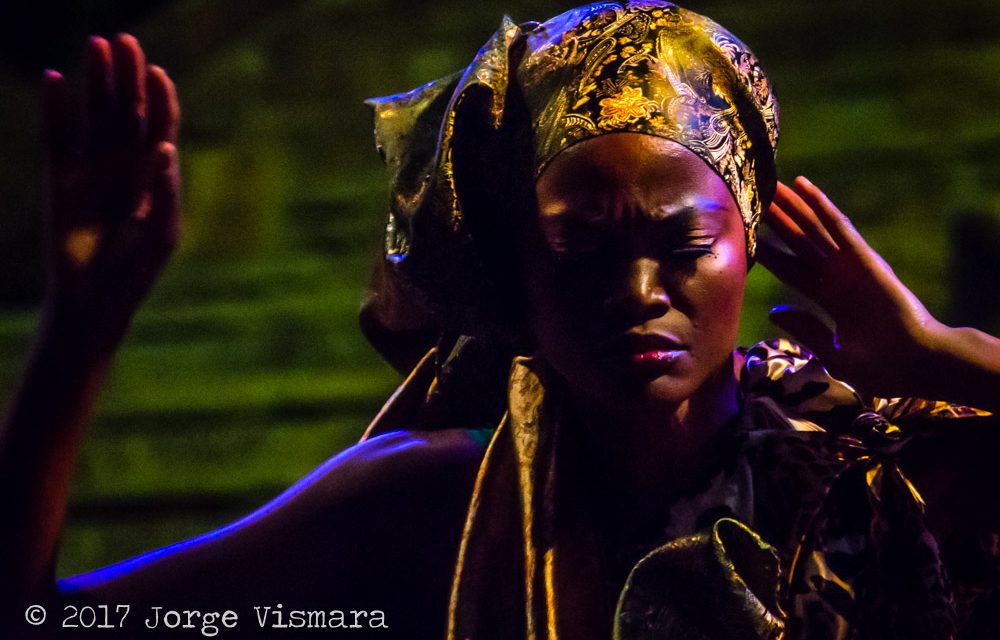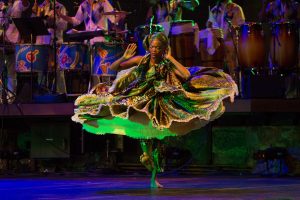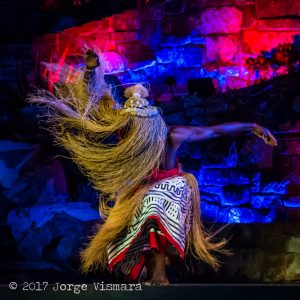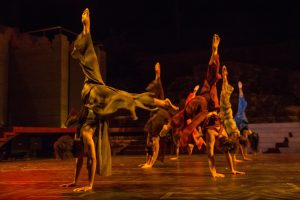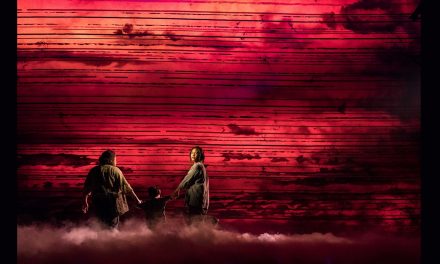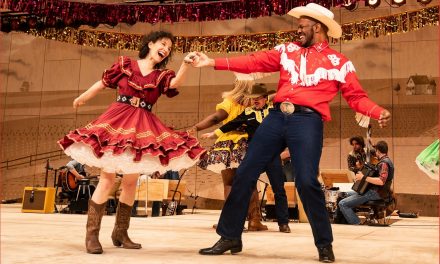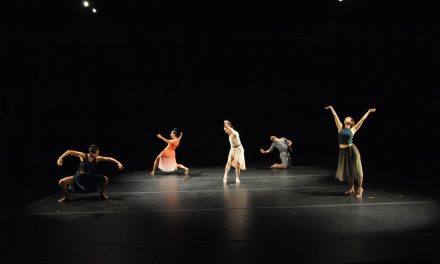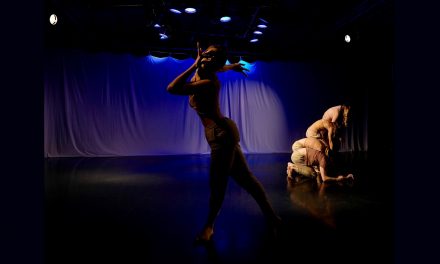Viver Brasil is celebrating its 20th year under the direction of Co-Artistic Directors Linda Yudin and Luiz Badaró. The company opened its new season with six colorful, energetic and music filled works under the cover title Agô Ayó Spirits Rising at the recently renovated John Anson Ford Theatres. Included were two world premieres choreographed by Brazilian born, based in Los Angeles Marina Magalhães and Salvador Bahia’s famous dancer and choreographer, Vera Passos.
The Ford Theatre stage was awash of color throughout the evening with the added treat of live music and song throughout. The beautiful costumes by Rosalida Medina, Elida Berry-Donat, Maria de Lourdes Silvestre dos Santos, and Laura Howe included ancestral goddesses’ gowns of gold, red, green and blue; traditional costumes of white or patterned blues and reds; abstract warriors in pastels, to a more contemporary look in browns and grays.
The style of dance originates from Salvador Bahia, Brazil. It is full of fast foot work, African dance-like back contractions and beautiful hip movements that almost hypnotize when the women are wearing long traditional style dresses. It is often fast, but there are sudden and poignant stops pregnant with proud and dramatic glances. The dances on Agô Ayó Spirits Rising told ancient stories, demonstrated ritual and ceremony as well as entertained.
The first work Avaninha originally choreographed by Rosangela Silvestre, re-staged by Vera Passos, had women dressed in solid white summoning the sacred energies of orixá, a spirit who reflects one of the manifestations of the supreme divinity Orisha. The women moved slowly and ritualistically before their movement intensified and the spirit appears descended on the stage level just above them. Vera Passos Orixás (2007) is costumed in rich reds, blues, green and yellows like parrots. It is a tale of the Orixás coming to earth to guide the world and the movement moved from a calm ritual of bathing to a sense of battle. Music was by José Ricardo Sousa with additional arrangements by Kahlil Cummings. Traditional chants shared by Ebomi Dona Cici.
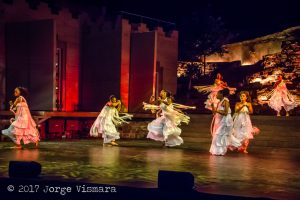
Viver Brasil, “Avanina”, Nagodé Simpson, Laila Abdullah, Ashley Blanchard, Rachel Hernandez, Ajah Muhammad, Bianca Medina, Vera Passos – Photo by Jorge Vismara
Singers Emina Shimanuki and Felicia “Onyi” Richards enhanced the evening with their amazing voices, but they truly inspired during a musical interlude titled Selected Chants for the River Goddess Oxum. These were songs shared by Dona Cici and arranged by Kahlil Cummings. The two women walked slowly down to the edge of the stage while singing, and even after they disappeared off stage, their beautiful songs could be heard.
Revealed is a beautiful tribute to the Brazilian culture’s ancestors who, if the youth listens, can be heard sharing their wisdom of strength and love. This is a quiet but powerful dance of protest and one that stresses the power of love. The music for Revealed was arrangements of traditional Candomblé music by Kahlil Cummings. Songs shared by Gilmar Sampaio and Dona Cici.
The two premieres were totally different in style and subject. Marina Magalhães’ premiere work Cor Da Pele [Skin Color] was a fusion of tradition Brazilian and North American contemporary dance. It is a very strong work, but needs editing. Vera Passos’ Pra Onde O Samba Me Leva [Where Samba May Take Me] was a beautiful and more traditional work that pays tribute to the memory of the great sambadeira, Joselita Moreira da Cruz Silva.
Motumbaxé by Vera Passos opened with a performance by singer Katia Moraes, whose energy was extremely contagious. Dancers in traditional dress celebrate “the resistance and resilience brought to the Bahian Carnaval by the Blocos Afro (Afro-Brazilian parading groups) in the 1970s”. The entire Viver Brasil ensemble brought the audience to their feet to join in the celebration. The work was exhilarating.
A 20th Anniversary is a good reason to pull out all the stops and give the company a platform to show their best. Viver Brasil succeeded in doing just that. The program was long, but how often does one reach such a milestone?
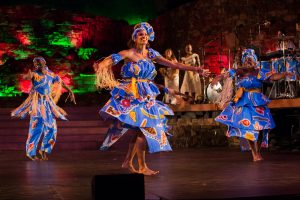
Viver Brasil, “Motumbaxé”, Samad-Guerra, Rachel Hernandez, Laila Abdullah, in back: Emina Shimanuki, Felicia “Onyi” Richards – Photo by Gia Trovela
The amazing dancers included Laila Abdullah, Bianca Medina, Ashley Blanchard, Samad Guerra, Rachel Hernandez, Marina Magalhães, Ajah Muhammad, Vera Passos and Nagodé Simpson. They were all especially beautiful, but my eye was constantly drawn to Nagodé Simpson, Rachel Hernandez, Bianca Medina and the extraordinarily beautiful Vera Passos.
The truly incredible and inspiring musicians for Agô Ayó Spirits Rising were Luiz Badaró (percussion), Simon Carroll (percussion), Kahlil Cummings (percussion), Bobby Easton (acoustic and electric guitar), Alberto Lopez (percussion), and Fabio Santana de Souza trombone, cavaquinho, acoustic guitar).
The man who lit up the stage in brilliant colors was Lighting Designer Tyler Lambert-Perkins.

